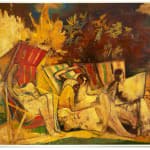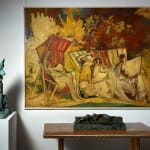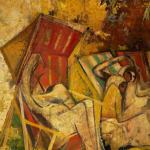Floris Jespers
Further images
Floris Egide Emile Jespers (Belgian, 1889-1965) was a multidisciplinary artist. Besides painting figures, portraits, landscapes, interiors, folkloric scenes, he was an important painter of ‘reverse glass painting’ and designed decorative panels and tapestries; he was also active as a muralist, watercolourist, etcher, woodcarver, sculptor and illustrator.
Floris Jespers (1862-1918) was the son of eclectic sculptor Emile Jespers (1862-1918) and brother of Oscar Jespers (1887-1970), avant-garde sculptor and medallist.
Jespers initially started studying music, which eventually allowed him to earn a living playing in theatre orchestras. From 1909, he studied at the Antwerp Academy and the NHISKA (National Higher Institute of Fine Arts in Antwerp) with Baron Frans Courtens.
He exhibited at the gallery Le Centaure in Brussels on a regular basis.
From 1910, he painted in his studio in Melsele. In 1914 he had his first encounter with the writer and poet Paul van Ostaijen, who would become his great friend and inspiration.
With time Jespers became recognised as an important Antwerp avant-garde figure of the 1920s. He debuted post-impressionist, evolving into cubism and then constructive poetic expressionism (1920-1930). Experiments with the abstract followed around 1920. After 1930, he created more intimate work in which he was influenced by Marc Chagall and H. Campendonck. He realised an extensive Congo oeuvre, inspired by the sculptural aura of the African body, highly stylised and rhythmically constructed, evoking the atmosphere of this continent that he had visited three times between 1951-1957. It also prompted him to sculpt.
Floris Jespers was a member of the art circles Sélection (1920) in Brussels, the Kunst van Heden (1921) in Antwerp and of Les Compagnons de l'Art (1932).
In 1937, he won the 'Grand Prix' at the Exposition Universelle de Paris for three tapestries.
In 1950, he became a member of the Royal Academy.
Museums: Antwerp, Brussels, Ostend, Grenoble







